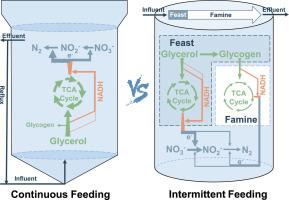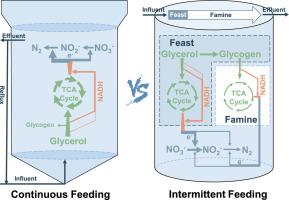间歇甘油喂养形成糖原储存表型,通过顺序反硝化增强亚硝酸盐积累
IF 12.4
1区 环境科学与生态学
Q1 ENGINEERING, ENVIRONMENTAL
引用次数: 0
摘要
实现稳定和高效的脱硝是为主流厌氧氨氧化工艺提供亚硝酸盐的一个很有前途的策略,但潜在的微生物机制仍然知之甚少,特别是像甘油这样的替代碳源。在这里,我们假设间歇性喂养可以通过选择特定的代谢表型来驱动更高的亚硝酸盐积累。为了测试这一点,在相同的碳限制条件下(COD/NO₃⁻-N = 3.5)运行了一个间歇投料的顺序批式反应器(SBR)和一个连续投料的厌氧污泥毯(UASB)反应器。SBR的亚硝酸盐积累效率(NiAE)为43.0±4.1%,显著高于UASB(18.9±5.4%)。基因组解析宏基因组学显示,SBR群落富含具有糖原储存潜力的物种,导致糖原代谢相关基因的总体丰度比UASB高45.8%。表型分析证实,SBR污泥含有更多的细胞内糖原,并且显示硝酸盐还原酶(NAR)与亚硝酸盐还原酶(NIR)的活性比比UASB污泥高一个数量级。这种动力学不平衡支撑了“顺序反硝化”表型,其中硝酸盐优先还原为亚硝酸盐。重要的是,在分批投料条件下,富含uasb的群落也表现出接近SBR培养物的高脱硝潜力,这表明这种表型是一种由甘油投料策略调节的可塑性性状,而不是群落结构的固定属性。这项研究揭示了一个基本机制,间歇性甘油可用性指导代谢通量向糖原储存,这反过来调节了NAR和NIR之间的电子分配。这突出了基因型潜力和实现表型之间的显著差异,为控制工程生态系统中氮转化途径提供了新的范例。本文章由计算机程序翻译,如有差异,请以英文原文为准。


Intermittent glycerol feeding shapes a glycogen-storing phenotype for enhanced nitrite accumulation via sequential denitrification
Achieving stable and efficient denitratation is a promising strategy to supply nitrite for mainstream anammox processes, yet the underlying microbial mechanisms remain poorly understood, especially with alternative carbon sources like glycerol. Here, we hypothesized that intermittent feeding regimes could drive higher nitrite accumulation by selecting for specific metabolic phenotypes. To test this, an intermittently-fed sequencing batch reactor (SBR) and a continuously-fed up-flow anaerobic sludge blanket (UASB) reactor were operated under identical carbon-restricted conditions (COD/NO₃⁻-N = 3.5). The SBR achieved a significantly higher and stable nitrite accumulation efficiency (NiAE) of 43.0 ± 4.1 % compared to the UASB (18.9 ± 5.4 %). Genome-resolved metagenomics revealed that the SBR community was enriched in species with glycogen-storing potential, leading to a 45.8 % greater overall abundance of genes related to glycogen metabolism compared to the UASB. Phenotypic analyses confirmed that the SBR sludge contained significantly more intracellular glycogen and displayed a nitrate reductase (NAR) to nitrite reductase (NIR) activity ratio that was an order of magnitude higher than the UASB sludge. This kinetic imbalance underpinned a “sequential denitrification” phenotype, where nitrate was preferentially reduced to nitrite. Critically, the UASB-enriched community, when subjected to batch-fed conditions, also exhibited a high denitratation potential close to the SBR culture, demonstrating that this phenotype is a plastic trait regulated by the glycerol feeding strategy rather than a fixed attribute of the community structure. This study uncovers a fundamental mechanism where intermittent glycerol availability directs metabolic flux towards glycogen storage, which in turn regulates electron partitioning between NAR and NIR. This highlights a significant divergence between genotypic potential and realized phenotype, offering a new paradigm for controlling nitrogen transformation pathways in engineered ecosystems.
求助全文
通过发布文献求助,成功后即可免费获取论文全文。
去求助
来源期刊

Water Research
环境科学-工程:环境
CiteScore
20.80
自引率
9.40%
发文量
1307
审稿时长
38 days
期刊介绍:
Water Research, along with its open access companion journal Water Research X, serves as a platform for publishing original research papers covering various aspects of the science and technology related to the anthropogenic water cycle, water quality, and its management worldwide. The audience targeted by the journal comprises biologists, chemical engineers, chemists, civil engineers, environmental engineers, limnologists, and microbiologists. The scope of the journal include:
•Treatment processes for water and wastewaters (municipal, agricultural, industrial, and on-site treatment), including resource recovery and residuals management;
•Urban hydrology including sewer systems, stormwater management, and green infrastructure;
•Drinking water treatment and distribution;
•Potable and non-potable water reuse;
•Sanitation, public health, and risk assessment;
•Anaerobic digestion, solid and hazardous waste management, including source characterization and the effects and control of leachates and gaseous emissions;
•Contaminants (chemical, microbial, anthropogenic particles such as nanoparticles or microplastics) and related water quality sensing, monitoring, fate, and assessment;
•Anthropogenic impacts on inland, tidal, coastal and urban waters, focusing on surface and ground waters, and point and non-point sources of pollution;
•Environmental restoration, linked to surface water, groundwater and groundwater remediation;
•Analysis of the interfaces between sediments and water, and between water and atmosphere, focusing specifically on anthropogenic impacts;
•Mathematical modelling, systems analysis, machine learning, and beneficial use of big data related to the anthropogenic water cycle;
•Socio-economic, policy, and regulations studies.
 求助内容:
求助内容: 应助结果提醒方式:
应助结果提醒方式:


